Abstract
Mutant mice produced by gene targeting in embryonic stem (ES) cells often have a complex or embryonic lethal phenotype. In these cases, it would be helpful to identify tissues and cell types first affected in mutant embryos by following the contribution to chimeras of ES cells homozygous for the mutant allele. Although a number of strategies for following ES cell development in vivo have been reported, each has limitations that preclude its general application. In this paper, we describe ES cell lines that can be tracked to every nucleated cell type in chimeras at all developmental stages. These lines were derived from blastocysts of mice that carry an 11-Mb beta-globin transgene on chromosome 3. The transgene is readily detected by DNA in situ hybridization, providing an inert, nuclear-localized marker whose presence is not affected by transcriptional or translational controls. The "WW" series of ES lines possess the essential features of previously described ES lines, including giving rise to a preponderance of male chimeras, all of which have to date exhibited germ-line transmission. In addition, clones selected for single or double targeting events form strong chimeras, demonstrating the feasibility of using WW6 cells to identify phenotypes associated with the creation of a null mutant.
Full text
PDF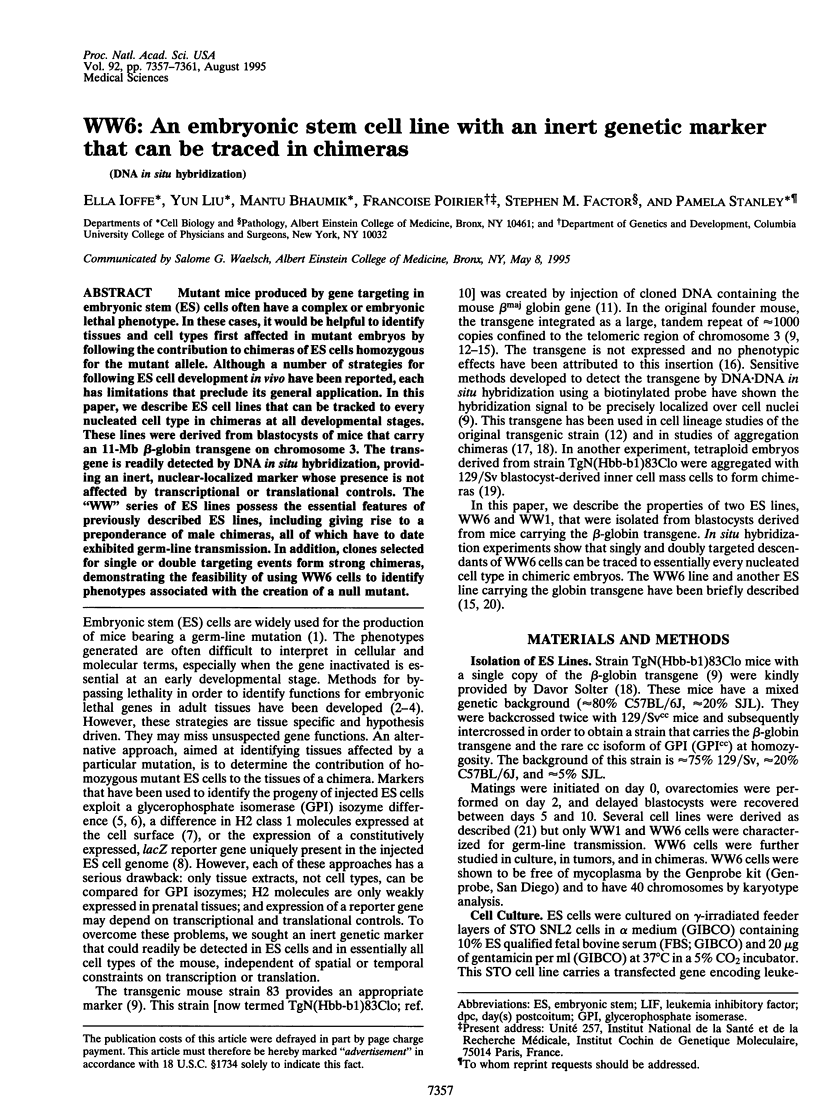
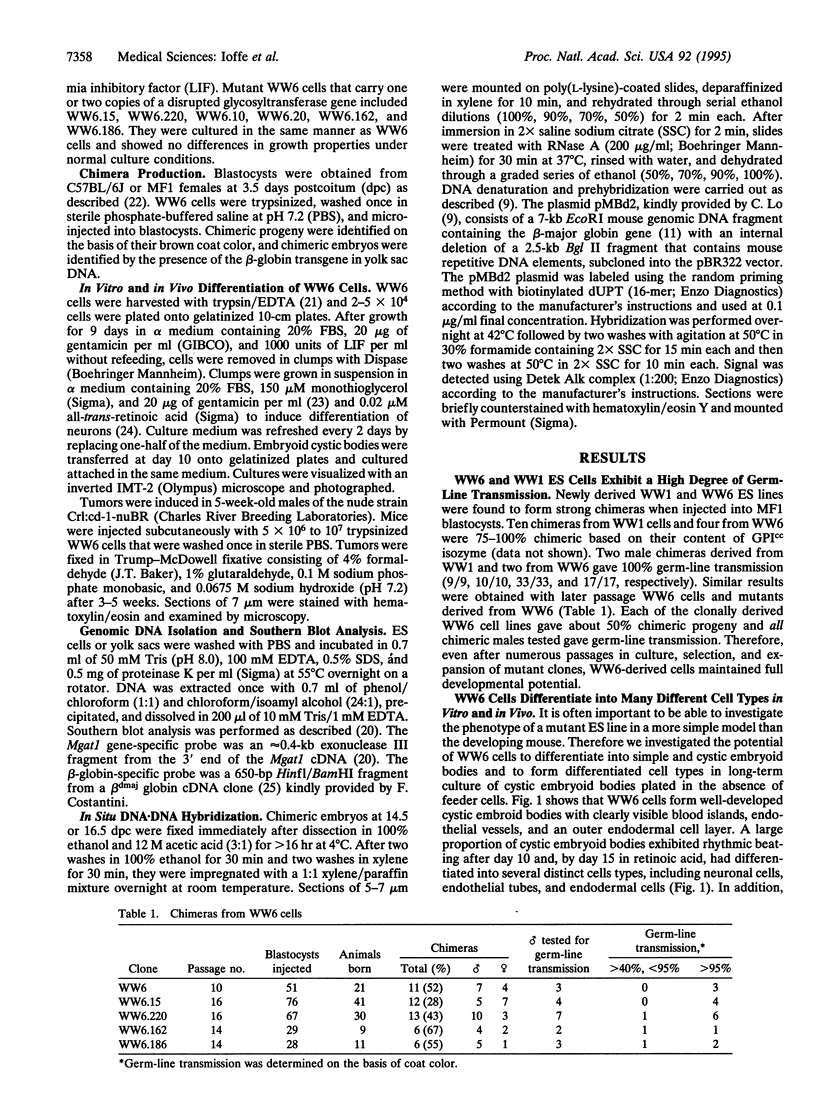
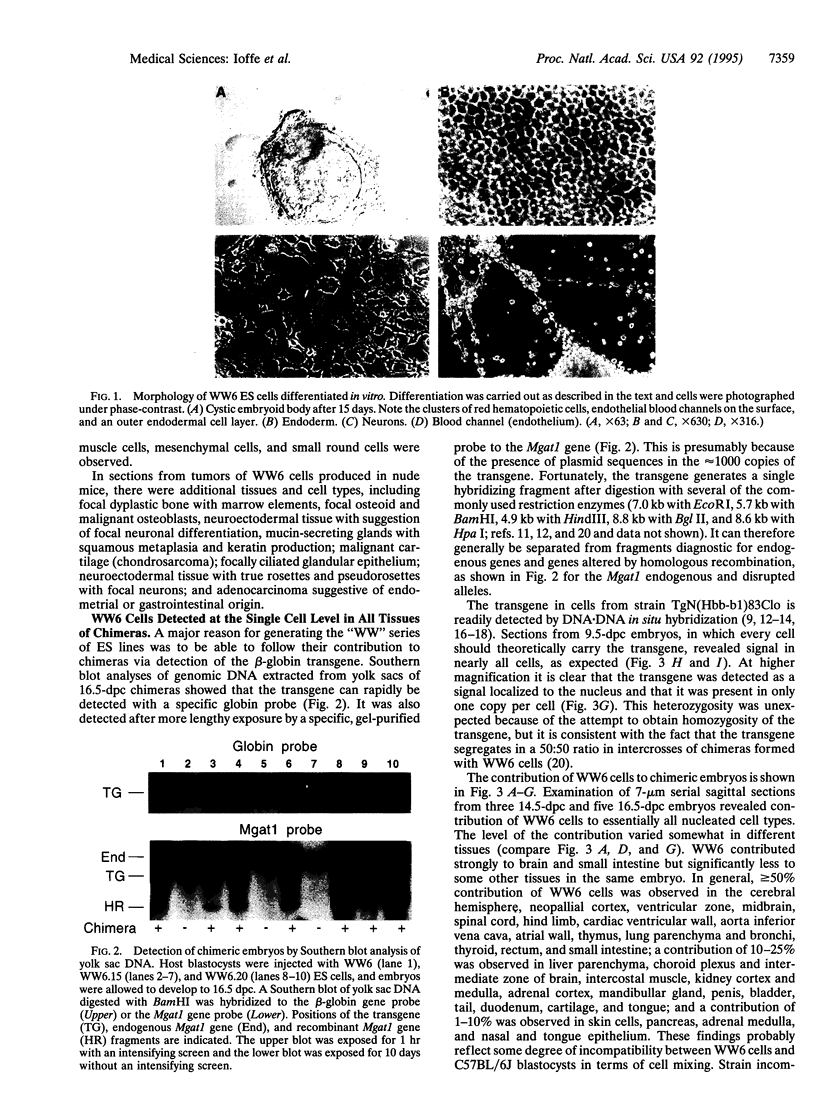
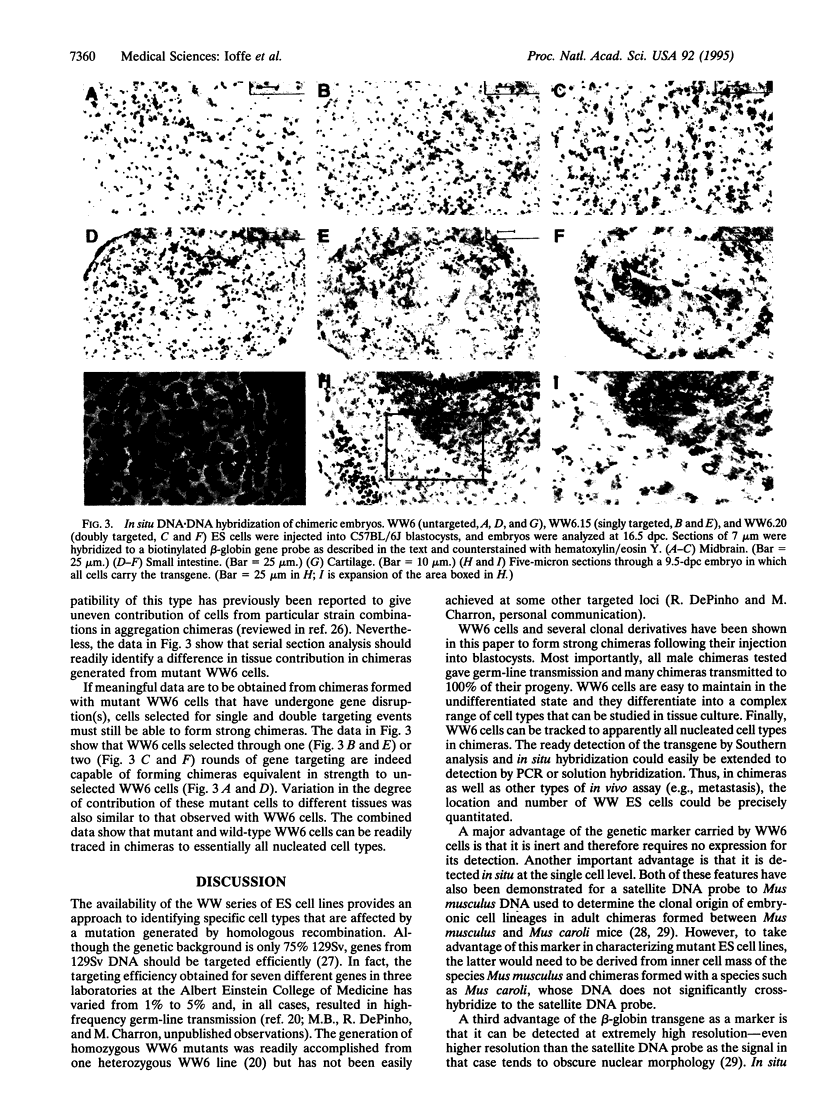
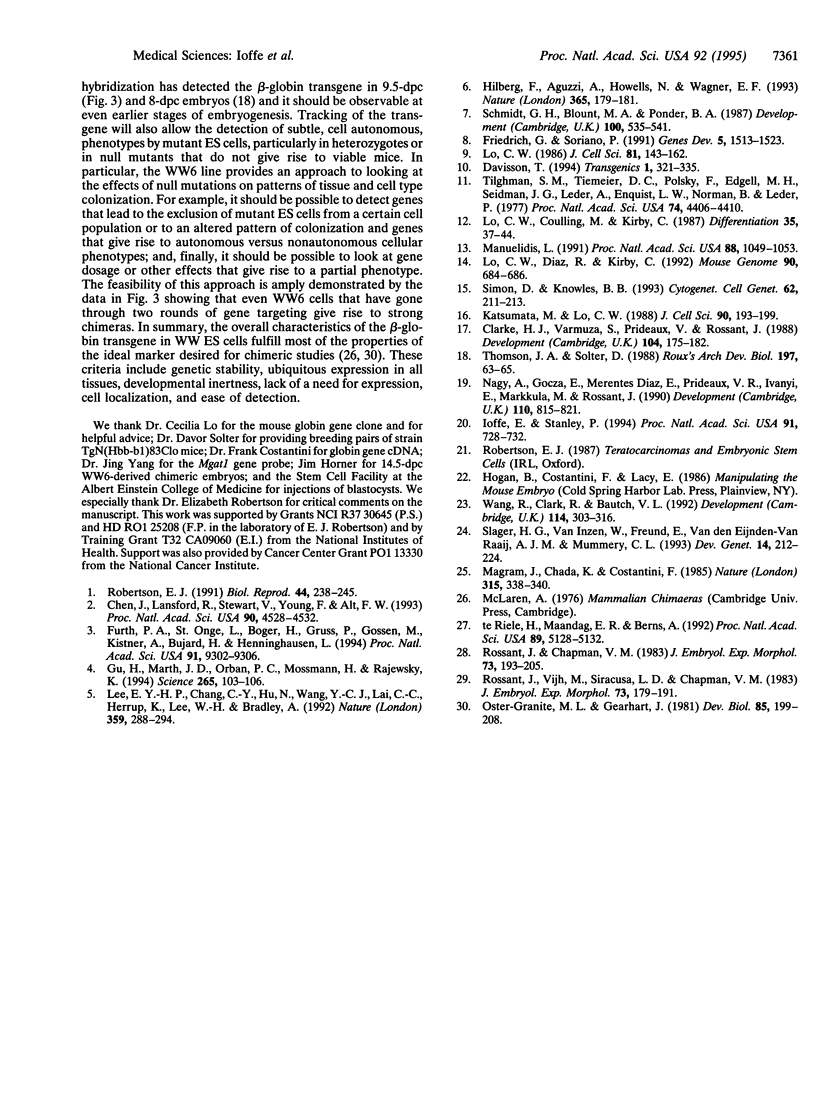
Images in this article
Selected References
These references are in PubMed. This may not be the complete list of references from this article.
- Chen J., Lansford R., Stewart V., Young F., Alt F. W. RAG-2-deficient blastocyst complementation: an assay of gene function in lymphocyte development. Proc Natl Acad Sci U S A. 1993 May 15;90(10):4528–4532. doi: 10.1073/pnas.90.10.4528. [DOI] [PMC free article] [PubMed] [Google Scholar]
- Clarke H. J., Varmuza S., Prideaux V. R., Rossant J. The development potential of parthenogenetically derived cells in chimeric mouse embryos: implications for action of imprinted genes. Development. 1988 Sep;104(1):175–182. doi: 10.1242/dev.104.1.175. [DOI] [PubMed] [Google Scholar]
- Friedrich G., Soriano P. Promoter traps in embryonic stem cells: a genetic screen to identify and mutate developmental genes in mice. Genes Dev. 1991 Sep;5(9):1513–1523. doi: 10.1101/gad.5.9.1513. [DOI] [PubMed] [Google Scholar]
- Furth P. A., St Onge L., Böger H., Gruss P., Gossen M., Kistner A., Bujard H., Hennighausen L. Temporal control of gene expression in transgenic mice by a tetracycline-responsive promoter. Proc Natl Acad Sci U S A. 1994 Sep 27;91(20):9302–9306. doi: 10.1073/pnas.91.20.9302. [DOI] [PMC free article] [PubMed] [Google Scholar]
- Gu H., Marth J. D., Orban P. C., Mossmann H., Rajewsky K. Deletion of a DNA polymerase beta gene segment in T cells using cell type-specific gene targeting. Science. 1994 Jul 1;265(5168):103–106. doi: 10.1126/science.8016642. [DOI] [PubMed] [Google Scholar]
- Hilberg F., Aguzzi A., Howells N., Wagner E. F. c-jun is essential for normal mouse development and hepatogenesis. Nature. 1993 Sep 9;365(6442):179–181. doi: 10.1038/365179a0. [DOI] [PubMed] [Google Scholar]
- Ioffe E., Stanley P. Mice lacking N-acetylglucosaminyltransferase I activity die at mid-gestation, revealing an essential role for complex or hybrid N-linked carbohydrates. Proc Natl Acad Sci U S A. 1994 Jan 18;91(2):728–732. doi: 10.1073/pnas.91.2.728. [DOI] [PMC free article] [PubMed] [Google Scholar]
- Katsumata M., Lo C. W. Organization of chromosomes in the mouse nucleus: analysis by in situ hybridization. J Cell Sci. 1988 Jun;90(Pt 2):193–199. doi: 10.1242/jcs.90.2.193. [DOI] [PubMed] [Google Scholar]
- Lee E. Y., Chang C. Y., Hu N., Wang Y. C., Lai C. C., Herrup K., Lee W. H., Bradley A. Mice deficient for Rb are nonviable and show defects in neurogenesis and haematopoiesis. Nature. 1992 Sep 24;359(6393):288–294. doi: 10.1038/359288a0. [DOI] [PubMed] [Google Scholar]
- Lo C. W., Coulling M., Kirby C. Tracking of mouse cell lineage using microinjected DNA sequences: analyses using genomic Southern blotting and tissue-section in situ hybridizations. Differentiation. 1987;35(1):37–44. doi: 10.1111/j.1432-0436.1987.tb00149.x. [DOI] [PubMed] [Google Scholar]
- Lo C. W. Localization of low abundance DNA sequences in tissue sections by in situ hybridization. J Cell Sci. 1986 Mar;81:143–162. doi: 10.1242/jcs.81.1.143. [DOI] [PubMed] [Google Scholar]
- Magram J., Chada K., Costantini F. Developmental regulation of a cloned adult beta-globin gene in transgenic mice. Nature. 1985 May 23;315(6017):338–340. doi: 10.1038/315338a0. [DOI] [PubMed] [Google Scholar]
- Manuelidis L. Heterochromatic features of an 11-megabase transgene in brain cells. Proc Natl Acad Sci U S A. 1991 Feb 1;88(3):1049–1053. doi: 10.1073/pnas.88.3.1049. [DOI] [PMC free article] [PubMed] [Google Scholar]
- Nagy A., Gócza E., Diaz E. M., Prideaux V. R., Iványi E., Markkula M., Rossant J. Embryonic stem cells alone are able to support fetal development in the mouse. Development. 1990 Nov;110(3):815–821. doi: 10.1242/dev.110.3.815. [DOI] [PubMed] [Google Scholar]
- Oster-Granite M. L., Gearhart J. Cell lineage analysis of cerebellar Purkinje cells in mouse chimeras. Dev Biol. 1981 Jul 15;85(1):199–208. doi: 10.1016/0012-1606(81)90251-7. [DOI] [PubMed] [Google Scholar]
- Robertson E. J. Using embryonic stem cells to introduce mutations into the mouse germ line. Biol Reprod. 1991 Feb;44(2):238–245. doi: 10.1095/biolreprod44.2.238. [DOI] [PubMed] [Google Scholar]
- Rossant J., Chapman V. M. Somatic and germline mosaicism in interspecific chimaeras between Mus musculus and Mus caroli. J Embryol Exp Morphol. 1983 Feb;73:193–205. [PubMed] [Google Scholar]
- Rossant J., Vijh M., Siracusa L. D., Chapman V. M. Identification of embryonic cell lineages in histological sections of M. musculus in-equilibrium M. caroli chimaeras. J Embryol Exp Morphol. 1983 Feb;73:179–191. [PubMed] [Google Scholar]
- Schmidt G. H., Blount M. A., Ponder B. A. Immunochemical demonstration of the clonal organization of chimaeric mouse epidermis. Development. 1987 Jul;100(3):535–541. doi: 10.1242/dev.100.3.535. [DOI] [PubMed] [Google Scholar]
- Simon D., Knowles B. B. Newly acquired peri-telomeric heterochromatin in a transgenic mouse lineage. Cytogenet Cell Genet. 1993;62(4):211–213. doi: 10.1159/000133478. [DOI] [PubMed] [Google Scholar]
- Slager H. G., Van Inzen W., Freund E., Van den Eijnden-Van Raaij A. J., Mummery C. L. Transforming growth factor-beta in the early mouse embryo: implications for the regulation of muscle formation and implantation. Dev Genet. 1993;14(3):212–224. doi: 10.1002/dvg.1020140308. [DOI] [PubMed] [Google Scholar]
- Tilghman S. M., Tiemeier D. C., Polsky F., Edgell M. H., Seidman J. G., Leder A., Enquist L. W., Norman B., Leder P. Cloning specific segments of the mammalian genome: bacteriophage lambda containing mouse globin and surrounding gene sequences. Proc Natl Acad Sci U S A. 1977 Oct;74(10):4406–4410. doi: 10.1073/pnas.74.10.4406. [DOI] [PMC free article] [PubMed] [Google Scholar]
- Wang R., Clark R., Bautch V. L. Embryonic stem cell-derived cystic embryoid bodies form vascular channels: an in vitro model of blood vessel development. Development. 1992 Feb;114(2):303–316. doi: 10.1242/dev.114.2.303. [DOI] [PubMed] [Google Scholar]
- te Riele H., Maandag E. R., Berns A. Highly efficient gene targeting in embryonic stem cells through homologous recombination with isogenic DNA constructs. Proc Natl Acad Sci U S A. 1992 Jun 1;89(11):5128–5132. doi: 10.1073/pnas.89.11.5128. [DOI] [PMC free article] [PubMed] [Google Scholar]





